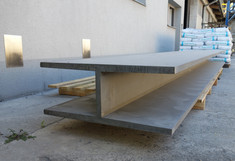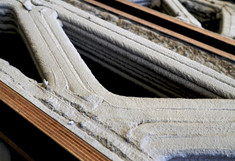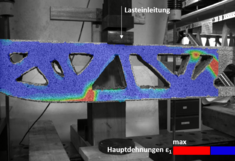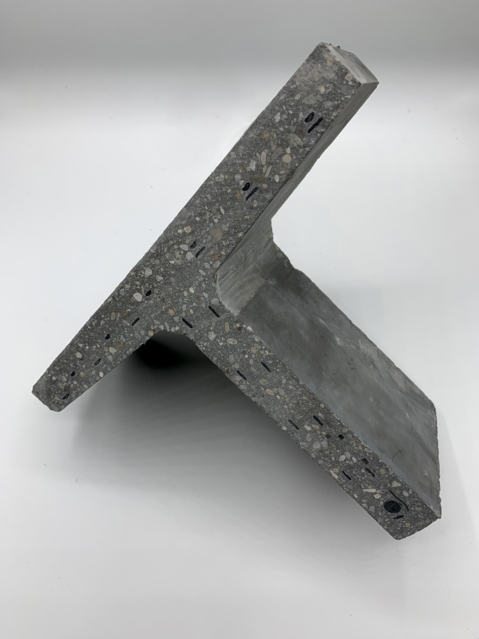Leichtbau und Automatisiertes Bauen mit Beton
Aus den Berichten der Internationalen Energieagentur geht hervor, dass Stahlbeton das weltweit meistgenutzte Baumaterial darstellt. In diesem Zusammenhang trägt die Herstellung von Zement, als unabdingbaren Bestandteil konventioneller Betone, mit einem Gesamtanteil von >4% entscheidend zum Ausstoß von anthropogenen Kohlenstoffdioxidemissionen bei. Die Erforschung von neuen Materialzusammensetzungen, Strukturen und Herstellungstechnologien, die zu einer geringeren Umweltbelastung führen ist somit zu den wichtigsten Aufgaben des Bauforschung der Gegenwart zu zählen.
Ein möglicher Ansatz, der vom IGCE momentan verfolgt wird, ist die Strukturoptimierung von Betonbauteilen. Somit soll nicht an der Lastabtragung beteiligtes Material eingespart und so die ökologische Effizienz erhöht werden. Aktuell werden beispielsweise strukturiert unterschiedliche Geometrien numerisch und experimentell untersucht.
Neben der Strukturoptimierung beleuchtet die Arbeitsgruppe ebenso das Potential von Hochleistungsmaterialien. Zusätzlich zu nichtmetallischer Bewehrung (Carbonfaserverbundkunststoffe CFK, Glasfaserverbundkunststoffe GFK und Basaltfaserverbundkunststoffe BFK – Textilien und Stäbe) kommen auch diverse Hochleistungsbetone (Hochfester Beton HPC, Ultrahochleistungsbeton UHPC, Ultrahochfester Faserbeton UHPFRC), jeweils mit dem Ziel den ökologischen Fußabdruck der Konstruktion zu minimieren, zum Einsatz.
Essentiell zur Umsetzung optimierter Betonbauteile, welche durch geometrisch komplexe, oftmals gar organisch anmutende Strukturen gekennzeichnet sind, ist die begleitende Erforschung entsprechender Fertigungsmethoden sowie Verbindungstechnologien. Die Arbeitsgruppe verfolgt diesbezüglich unterschiedliche Ansätze z.B. die Verwendung von 3D Druck von Beton, die Verwendung von 3D gedruckten Schalungen oder auch vergleichend konventionelles Gießen. Langfristig wird ein Ansatz für robotergestütztes automatisiertes bewehren, Schalen und Gießen verfolgt, da so ein stabilerer Prozess mit höherer Performance möglich ist. Siehe auch das Projekt AUTOMCONCRETE.
Das IGCE beteiligt sich außerdem an der Etablierung der neuen Werkstoffkombination aus nichtmetallischer Bewehrung und Beton im Zuge des Projekts SusDeCon “Nachhaltiges Konstruieren und Bauen mit nichtmetallischen Bewehrungen”. Hier wird in einem breit aufgestellten Projektteam aus universitären Einrichtungen, Planer*innen, Bewehrungshersteller*innen und Ausführenden Grundlagenarbeit für die praxisnahe Anwendbarkeit nichtmetallischer Bewehrungen geleistet.
Schlagwörter: Carbonbewehrung, CFK, UHPC, innovative Baustoffe, Leichtbeton, Topologieoptimierung
Kontaktpersonen:
News:
Publikationen:
2025
Pressmair N., Hammerl M., Reichenbach S., Kromoser B.: Evolution of material-efficient concrete girders: Conceptual design informed by topology optimisation and experimental testing regime DOI: 10.1016/j.engstruct.2024.119535
2024
Hammerl M., Reichenbach S., Pressmair N., Kromoser B.: Short‐length mechanical bond anchorage for reinforcement bars made of FRP: Experimental and numerical investigations DOI: 10.1002/suco.202400066
2023
Hammerl M., Reichenbach S., Kromoser B.,Thin-Walled Slab Elements Made of FRP-Reinforced HPC and UHPC: Development, Experimental Investigation and LCA DOI: Symposium 2023. 2023.
2022
Hammerl M., Kromoser B.: Filigree Slab Elements made of Carbon reinforced HPC - Development, Production and Experiments DOI: September 2022
Hammerl M., Kromoser B.: Bending failure mechanisms of non-prestressed and prestressed thin-walled uhpc beams reinforced with CFRP DOI: Proceedings fib Congress 2022 Oslo
Pressmair N, Brosch F, Hammerl M, Kromoser B. Non-linear material modelling strategy for conventional and high-performance concrete assisted by testing DOI: 10.1016/j.cemconres.2022.106933
Hammerl, M; Kromoser, B Bending Behaviour of Prestressed T-Shaped Concrete Beams Reinforced with FRP-Experimental and Analytical Investigations. DOI :10.3390/ma15113843
Preinstorfer, P; Huber, T; Reichenbach, S; Lees, JM; Kromoser, B Parametric Design Studies of Mass-Related Global Warming Potential and Construction Costs of FRP-Reinforced Concrete Infrastructure.DOI :10.3390/ma15113843
Brosch, F; Stoiber, N; Hammerl, M; Kromoser, B (2022): NUMERICAL MODELLING STRATEGY FOR UHPC STRUCTURES: MODEL CALIBRATION ASSISTED BY TESTING AND APPLICATION ON A HIGH-PERFORMANCE BEAM.
[fib Congress 2022 Oslo, Oslo, NORWAY, 13.06.2022 - 16.06.2022]
Reichenbach, S; Stoiber, N; Kromoser, B (2022): Cradle-to-gate LCA of FRP reinforcement for concrete structures.
[fib Congress 2022 Oslo - Concrete Innovation for Sustainability, Oslo, NORWAY, 13.06.2022 - 16.06.2022]
Stoiber, N; Hammerl, M; Kromoser, B (2022): Environmental Assessment of Non-metallic Reinforcement for Concrete Structures as an Alternative to Steel Reinforcement . DOI: Vol. 33 (2022):
2021
Stoiber, N.; Kromoser, B: Topology optimization in concrete construction: a systematic review on numerical and experimental investigations. 2021, Structural and Multidisciplinary Optimization. 64: 1725-1749. DOI: https://doi.org/10.1007/s00158-021-03019-6
Stoiber, N.; Kromoser, B. (2021): Pushing concrete material usage to the limit: Weight optimized, 3D printed concrete girders with external reinforcement. [International fib Symposium – Conceptual Design of Structures 2021, Switzerland, 16. – 18. September 2021]
Hammerl, M; Kromoser, B The influence of pretensioning on the load-bearing behaviour of concrete beams reinforced with carbon fibre reinforced polymers. DOI:10.1007/s00158-021-03019-6
Preinstorfer, P; Huber, P; Huber, T; Kromoser, B; Kollegger, J Experimental investigation and analytical modelling of shear strength of thin walled textile-reinforced UHPC beams.DOI: https://forschung.boku.ac.at/de/publications/136265
Reichenbach, S; Preinstorfer, P; Hammerl, M; Kromoser, B A review on embedded fibre-reinforced polymer reinforcement in structural concrete in Europe. DOI:Construction and Building Materials. 2021;307.
Hammerl, M; Kromoser, B (2021): Load-bearing Behaviour of Pretensioned Thin-walled Concrete Structures Reinforced with CFRP.
Preinstorfer, P; Reichenbach, S; Huber, T; Kromoser, B (2021): Potential Fields of Application for CFRP Reinforcement in Concrete Infrastructure Engineering: Material Availability, Application Areas and Static Parametric Study with Consideration of the GWP.
Reichenbach, S; Kromoser, B; Preinstorfer, P; Huber, T (2021): Application potential of textile reinforcement in concrete construction for infrastructure buildings: Environmental performance and availability.
Kromoser, B.: (2021): Ressourceneffizientes Bauen mit Betonfertigteilen. Material - Struktur - Herstellung.
Preinstorfer, P; Kromoser, B Influence of geometrical parameters on the splitting forces in textile-reinforced concrete. DOI: Materials and Structures. 2020;53(6).
Suppanz, F; Kromoser, B Bond behavior of subtractive machined CFRP rods in UHPC. DOI: Beton- und Stahlbetonbau. 2020;115(7):504-+.
2020
Hammerl, M; Kromoser, B (2020): Prestressing of carbon fiber reinforced concrete.
Kromoser, B; Preinstorfer, P; Kollegger, J Building lightweight structures with carbon-fiber-reinforced polymer-reinforced ultra-high-performance concrete: Research approach, construction materials, and conceptual design of three building components. DOI: Structural Concrete. 2019;20(2):730-44.
Preinstorfer, P; Kromoser, B; Kollegger, J Categorisation of the bond behaviour of textile reinforced concrete. DOI: Bauingenieur. 2019;94(11):416-24.
Preinstorfer, P; Kromoser, B; Kollegger, J Flexural behaviour of filigree slab elements made of carbon reinforced UHPC. DOI: Construction and Building Materials. 2019;199:416-23.
2019
Kromoser, B (2019): Thin walled CFRP reinforced UHPC structures – towards efficiency in concrete engineering?.
2018 Originalbeitrag in Fachzeitschrift
Kromoser, B; Kollegger, J Conceptual design, geometry optimization and calculation of the concrete shell bridge AM2 built with PFHC. DOI: Beton- und Stahlbetonbau. 2018;113(2):88-95.
Kromoser, B; Kollegger, J; Kari, H; Gradenegger, K; Ganster, M Practical Application of an innovative concrete shell construction method: Construction of the deer pass AM2 by use of PFHC. DOI: Beton- und Stahlbetonbau. 2018;113(3):222-3.
Publizierter Beitrag für wissenschaftliche Veranstaltung
Kollegger, J.; Kromoser, B.; Suza, D.: (2018): Erection of bridges and shells without formwork - challenges for the computational modelling. [Conference on Computational Modelling of Concrete and Concrete Structures (Euro-C), Bad Hofgastein, 26. February - 1 March 2018] In: Meschke, G.; Pichler, B.; Rots J.G. (Eds.), Computational Modelling of Concrete Structures ; ISBN: 978-1-138-74117-1
2017 Originalbeitrag in Fachzeitschrift
Kromoser, B; Kollegger, J Active Shaping of hardened Concrete Elements for the Production of spatially crushed Concrete Surfaces. DOI: Beton- und Stahlbetonbau. 2017;112(2):106-15
Kromoser, B.; Kollegger, J.: (2017): Construction of a thin walled concrete shell event canopy. [CCC Tokaj, Tokaj, 31.08. - 1.09.2017]
Kromoser, B.; Kollegger, J.: (2017): How to inflate a hardened concrete shell with a weight of 80 t. [IASS Annual Symposium 2017 , Hamburg, 25. - 28. September 2017]
Preinstorfer, P.; Kromoser, B.; Kollegger, J.: (2017): Dünnwandige Bauteile aus carbonbewehrtem Ultrahochleistungsbeton . [VÖZ Kolloquium 2017, Wien, 13.11.2017]
Preinstorfer, P.; Kromoser, B.,;Kollegger, J.: (2017): Development of prestressed T-beams made of textile reinforced UHPC. [39th IABSE Symposium, Vancouver, 19. - 23. September 2017]
2016 Originalbeitrag in Fachzeitschrift
Hawkins W., Herrmann M., Ibell T., Kromoser B., Michaelski A., Orr J., Pedreschi R., Pronk A., Schipper R., Shepherd P., Veenendaal D., Wansdronk R., West M.: Flexible formwork technologies - a state of the art review. DOI: Structural Concrete. 2016;17(6):911-35.
Kromoser B., Huber P.: Pneumatic Formwork Systems in Structural Engineering. DOI: Advances in Materials Science and Engineering. 2016
Kromoser B, Ritt M.: Optimized shapes for textile reinforced concrete structures - design of the barbecue furniture "Donauwelle". DOI: Bauingenieur. 2016;91:425-33.
Publizierter Beitrag für wissenschaftliche Veranstaltung
Kromoser B., Kollegger J., Pachner,T.: (2016): Building concrete shells without formwork and falsework. [fib Symposium 2016 , Cape Town, 21. - 23. November 2016]
Kromoser B., Kollegger J.: (2016): Structural Optimization of a concrete shell bridge with the Pneumatic Forming of Hardened Concrete construction method. [IASS 2016 International Symposium, Tokyo, 26.9. - 30.9.2016]
Preinstorfer P., Kromoser B., Kollegger J.: (2016): On the Bond Behaviour between Double-Wall Elements made of HPC/UHPC and ordinary cast-in-situ Concrete.
[HIPERMAT 2016, Kassel, 9.3. - 11.3.2016]
2015 Originalbeitrag in Fachzeitschrift
Kromoser B; Kollegger J Pneumatic forming of hardened concrete - building shells in the 21st century. DOI: Structural Concrete. 2015;16(2):161-7.
Kromoser B.; Kollegger J.: (2015): Application Areas for Pneumatic Forming of Hardened Concrete. Journal of the IASS, 56, 187-198; ISSN 1028-365X
Publizierter Beitrag für wissenschaftliche Veranstaltung
Kollegger J.; Kromoser B.: (2015): Neue Tragwerke – Eine Betonkuppel zum Aufblasen.
[59. Betontage Ulm, Ulm, 24. - 26.2.2015]
Kromoser B.: (2015): Thin-walled textile concrete furniture. [The 11th Central European Concress on Concrete Engineering, Hainburg, 1.10. - 2.10.2015]
Kromoser B.; Kollegger J.: (2015): Building shells from initially flat hardened concrete plates.
[IASS 2015, Amsterdam , 17.8. - 20.8.2015]
Dissertation
Kromoser B.: (2015): Pneumatisches Verformen Von Ausgehärtetem Beton - Die Errichtung Von Betonschalen Aus Ursprünglich Ebenen Platten. ; TU Wien, Institut für Tragkonstruktionen - Forschungsbereich für Stahlbeton und Massivbau
2014 Originalbeitrag in Fachzeitschrift
Kromoser B., Kollegger J,; Manufacturing of shell structures made of concrete with the "Pneumatic Wedge Method" A new Construction Method for the Construction of Double-Curved Concrete Surface by using Pneumatic Formwork. DOI: Beton- und Stahlbetonbau. 2014;109(8):557-65
Kromoser B., Kollegger J.: (2014): Building free formed concrete surfaces by using the “pneumatic wedge method. [The 10th fib International PhD Symposium in Civil Engineering , Quebec, 21.7. - 23.7.2014] ; ISBN: 978-2-9806762-1-5






